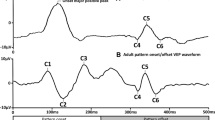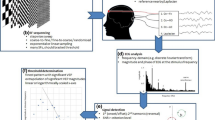Abstract
Purpose: The objective detection of local visual field defects using multi-focal pattern visual evoked potentials (VEP) has recently been described. The individual waveforms show variable polarity in different parts of the visual field due to underlying cortical convolutions. Normal trace arrays were examined to determine if certain areas of similar waveform could be grouped for analysis, while minimising cancellation of data. Method: The VEP was assessed using multi-focal pseudo-randomly alternated pattern stimuli which were cortically scaled in size. Bipolar occipital electrodes were used for recording. Waveforms were compared for different locations within the field up to 25° of eccentricity. Analysis of sectors showing similarly shaped waveforms was performed. Twelve normal subjects were studied. Result: Grouping waveforms by sectors of similar waveform increased the total calculated upper hemifield amplitude by 60%, compared with simple summations of responses for the whole hemifield. The inferior hemifield showed more consistent waveforms throughout, with the amplitude only increasing by 11% with sectoral summation. Intra-subject variability (10.6%) is less for sectors than for individual points (17.3%). Inter-subject amplitude differences are high, calculated at 56% for individual points and 45% for sectors. Conclusions: Due to differences in waveform as a result of underlying cortical anatomy, individual VEP responses from multifocal recordings should be grouped as sectors along the vertical meridian and above and below the horizontal, rather than by hemifields or quadrants. This finding is significant if one is considering within-field grouping strategies similar to the glaucoma hemifield test used in conventional perimetry, or reporting derived overall VEP amplitudes and latencies from a multifocal recording. Large amplitude variations between individuals and small signals from horizontal and upper field seen in single channel recording, still limit the application of this technique as a form of objective perimetry.
Similar content being viewed by others
References
Klistorner Al, Graham SL, Grigg JR, Billson FA. Electrode position and the multi-focal visual-evoked potential: Role in objective visual field assessment. Aust NZ J Ophthalmol 1998: 26: 91–94.
Klistorner Al, Graham SL, Grigg JR, Billson FA. Multifocal topographic visual evoked potential: improving objective detection of local visual field defects. Invest Ophthalmol Vis Sci 1998: 39: 937–50.
Graham SL, Klistorner A. Electrophysiology:a review of signal origin and applications to investigating glaucoma. Aust NZ J Ophthalmol 1998: 26: 71–85.
Graham SL, Klistorner A, Grigg JR, Billson FA. Objective perimetry in glaucoma-recent advances using multifocal stimuli. Surv Ophthalmol 1999: 43 (Suppl 1): s199–209
Howe J, Mitchell K. Visual evoked cortical potentials to paracentral retinal stimulation in chronic glaucoma, ocular hypertension and an age-matched group of normals. Doc Ophthalmol 1986: 63: 37–44.
Gazarek 5, Henning G, Muller W. Experimental studies of locally generated focal VECP within the 30 degree visual field with LED. Ophthalmologe 1995: 92: 1134–9.
Cappin JM, Nissim S. Visual evoked responses in the assessment of field defects in glaucoma. Arch Ophthalmol 1975: 93: 9–18.
Howe JW, Mitchell KW. Visual evoked potentials from quadrantic field stimulation in the investigation of homonymous field defects. In: Barber C, ed. Evoked potentials. Lancaster: MTP Press, 1980: 279–83.
Schlykowa L, van Dijk BW, Ehrenstein WH. Motion-onset visual-evoked potentials as a function of retinal eccentricity in man. Brain Res. 1993: 169–74.
Brusa A, Mortimer C, Jones SJ. Clinical evaluation of VEPs to interleaved checkboard reversal stimulation of central, hemi-and peripheral fields. Electroenceph Clin Neurophys 1995: 96: 485–94.
Bradham MS, Montgomery DM, Evans AL, et al. Objective detection of hemifield and quadrantic field defects by visual evoked cortical potential. Br J Ophthalmol 1996: 80: 297–303.
Blumhardt LD, Barett G, Halliday AM. The assymetrical visual evoked potential to pattern reversl in one half field and its significance for the analysis of visual field defects. Br J Ophthalmol 1977: 61: 454–61.
Celesia GG, Meredith JT. Visual evoked responses and retinal eccentricity. In: Bodis-Wollner, ed. Evoked potentials. New York: New York Academy of Science, 1982: 648–5O.
Lan C, Song G, Zeng L. Quadrant pattern visual evoked potential in normal eyes. Chin J Ophthalmol 1996: 31: 209–11.
Horton JC, Hoyt F. The representation of the visual field in the human striate cortex. Arch Ophthalmol 1991: 109: 816–24.
Holmes G. Disturbance of vision by cerebral lesions. Br J Ophthalmol 1918: 2: 353–384.
McFadzean R, Brosnahan D, Hadley D, Mutlucan E. Representation of the visual field in the occipital striate cortex. Br J Ophthalmol 1994: 78: 185–90.
Halliday AM, Barret G, Halliday E, Michael WF. The topography of the pattern-evoked potential. In: Desmedt JE, ed. Visual evoked potential in man: new developments. Oxford: Clarendon Press, 1977: 121–33.
Michael WF, Halliday AM. Differencies between the occipital distribution of upper and lower field pattern-evoked responses in man. Brain Res 1971: 32: 311–24.
Baseler HA, Sutter EE. M and P components of the VEP and their visual field contribution. Vis Res 1997: 37: 675–790.
Cowey A, Polls ET. Human cortical magnification factor and its relation to visual acuity. Brain Res 1974: 21: 447–454.
Whitteridge D, Daniel PM. The representation of the visual field on the calcarine cortex. In: Jung R, Kornhuber H, eds. The Visual system: neurophysiology and psychophysics. Berlin: Springer-Verlag, 1966: 222–8.
Jeffreys D. The physiological significance of the pattern visual evoked potentials. In: Desmedt JE, ed. Visual evoked potentials in man: new developments. Oxford: Clarendon Press, 1977: 134–67.
Jeffreys DA, Axford JG. Source localisation of pattern-specific components of human visual evoked potentials. Exp Brain Res 1972: 16: 1–21.
Graham SL, Klistorner A, Grigg JR, Billson FA. Objective perimetry in glaucoma: improved signals using multichannel recording. Invest Ophthalmol Vis Sci 1999 (ARVO abstract);40(4): #318:s67
Rights and permissions
About this article
Cite this article
Klistorner, A.I., Graham, S.L. Multifocal pattern VEP perimetry: analysis of sectoral waveforms. Doc Ophthalmol 98, 183–196 (1999). https://doi.org/10.1023/A:1002449304052
Issue Date:
DOI: https://doi.org/10.1023/A:1002449304052




